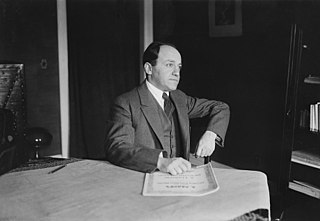Related Research Articles

Isaac Stern was an American violinist.
Ellen Taaffe Zwilich is an American composer, the first female composer to win the Pulitzer Prize for Music. Her early works are marked by atonal exploration, but by the late 1980s, she had shifted to a postmodernist, neoromantic style. She has been called "one of America's most frequently played and genuinely popular living composers." She was a 1994 inductee into the Florida Artists Hall of Fame. Zwilich has served as the Francis Eppes Distinguished Professor at Florida State University.
The concerto grosso is a form of baroque music in which the musical material is passed between a small group of soloists and full orchestra. This is in contrast to the solo concerto which features a single solo instrument with the melody line, accompanied by the orchestra.

Bohuslav Jan Martinů was a Czech composer of modern classical music. He wrote 6 symphonies, 15 operas, 14 ballet scores and a large body of orchestral, chamber, vocal and instrumental works. He became a violinist in the Czech Philharmonic Orchestra, and briefly studied under Czech composer and violinist Josef Suk. After leaving Czechoslovakia in 1923 for Paris, Martinů deliberately withdrew from the Romantic style in which he had been trained. During the 1920s he experimented with modern French stylistic developments, exemplified by his orchestral works Half-time and La Bagarre. He also adopted jazz idioms, for instance in his Kitchen Revue.

A string orchestra is an orchestra consisting solely of a string section made up of the bowed strings used in Western Classical music. The instruments of such an orchestra are most often the following: the violin, which is divided into first and second violin players, the viola, the cello, and usually, but not always, the double bass.

Trevor David Pinnock is a British harpsichordist and conductor.

Alfred Garrievich Schnittke was a Russian composer. Among the most performed and recorded composers of late 20th-century classical music, he is described by musicologist Ivan Moody as a "composer who was concerned in his music to depict the moral and spiritual struggles of contemporary man in [...] depth and detail."

Ernest Bloch was a Swiss-born American composer. Bloch was a preeminent artist in his day, and left a lasting legacy. He is recognized as one of the greatest Swiss composers in history. As well as producing musical scores, Bloch had an academic career that culminated in his recognition as Professor Emeritus at the University of California, Berkeley in 1952.
Ralph Leonard Kirkpatrick was an American harpsichordist and musicologist, widely known for his chronological catalog of Domenico Scarlatti's keyboard sonatas as well as for his performances and recordings.
The Concerto for Two Violins in D minor, BWV 1043, also known as the Double Violin Concerto, is a violin concerto of the Late Baroque era, which Johann Sebastian Bach composed around 1730. It is one of the composer's most successful works.

William Quincy Porter was an American composer and teacher of classical music.

Erwin Schulhoff was an Austro-Czech composer and pianist. He was one of the figures in the generation of European musicians whose successful careers were prematurely terminated by the rise of the Nazi regime in Germany and whose works have been rarely noted or performed.
Cecile Buencamino Licad is a Filipina classical pianist. She was born in Manila.
William Joseph Russo was an American composer, arranger, and musician from Chicago, Illinois, United States.
Louis Boyd Neel O.C. was an English, and later Canadian conductor and academic. He was Dean of the Royal Conservatory of Music at the University of Toronto. Neel founded and conducted chamber orchestras, and contributed to the revival of interest in baroque music and in the 19th and 20th Century string orchestra repertoire.
Concerto Grosso for String Orchestra may refer to:

The Concerti grossi, Op. 3, HWV 312–317, are six concerti grossi by George Frideric Handel compiled into a set and published by John Walsh in 1734. Musicologists now agree that Handel had no initial knowledge of the publishing. Instead, Walsh, seeking to take advantage of the commercial success of Corelli's Concerti grossi, Op. 6, simply combined several of Handel's already existing works and grouped them into six "concertos".
The concerto transcriptions of Johann Sebastian Bach date from his second period at the court in Weimar (1708–1717). Bach transcribed for organ and harpsichord a number of Italian and Italianate concertos, mainly by Antonio Vivaldi, but with others by Alessandro Marcello, Benedetto Marcello, Georg Philipp Telemann and the musically talented Prince Johann Ernst of Saxe-Weimar. It is thought that most of the transcriptions were probably made in 1713–1714. Their publication by C.F. Peters in the 1850s and by Breitkopf & Härtel in the 1890s played a decisive role in the Vivaldi revival of the twentieth century.
The Concertone for Two Violins and Orchestra in C major, K. 190 (186e) was written by Wolfgang Amadeus Mozart in May 1774.
References
- ↑ Sills, David L. (1985). Bloch Manuscripts at the University of California. Second Series, Vol. 42, No. 1 (Sep., 1985), pp. 7-21
- ↑ Sills, David L. (1986). Bloch Manuscripts at the Library of Congress. Second Series, Vol. 42, No. 4 (Jun., 1986), pp. 727-753
- ↑ Morin, Alexander J., Ed. (2002). Classical music: the listener's companion, p. 155. Hal Leonard Corporation, ISBN 978-0-87930-638-0
- ↑ Downes, Olin (April 11, 1926). Programs of an Orchestra Season Qualities of Works of Modern Men. The New York Times
- ↑ Downes, Olin (October 9, 1927). Ernest Bloch's quintet; Modern in Feeling, Work Is Classic in Structure -- Performed by Malkin Trio. The New York Times
- ↑ Wilson, Colin (1966). Chords and Discords: Purely Personal Opinions on Music, p. 110. Maurice Bassett, ISBN 978-1-60025-023-1